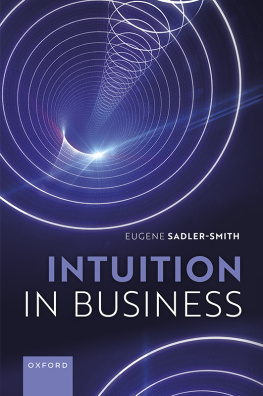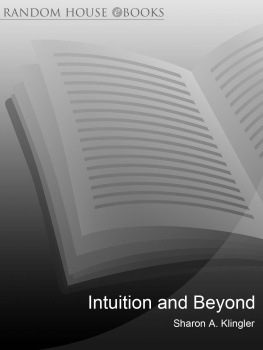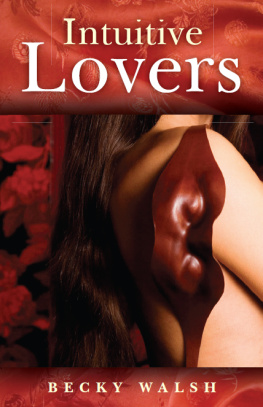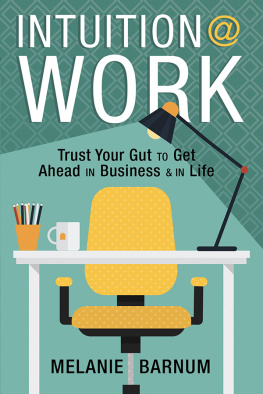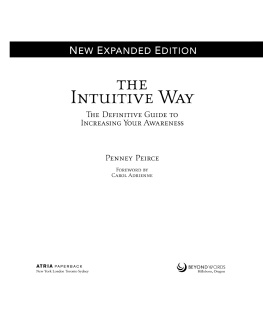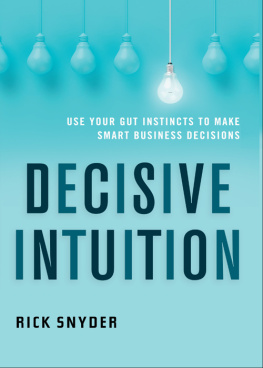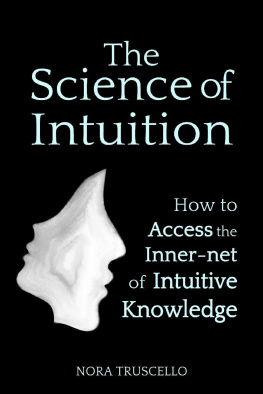

Great Clarendon Street, Oxford, OX2 6DP,
United Kingdom
Oxford University Press is a department of the University of Oxford. It furthers the Universitys objective of excellence in research, scholarship, and education by publishing worldwide. Oxford is a registered trade mark of Oxford University Press in the UK and in certain other countries
Eugene Sadler-Smith 2023
The moral rights of the author have been asserted
Impression: 1
All rights reserved. No part of this publication may be reproduced, stored in a retrieval system, or transmitted, in any form or by any means, without the prior permission in writing of Oxford University Press, or as expressly permitted by law, by licence or under terms agreed with the appropriate reprographics rights organization. Enquiries concerning reproduction outside the scope of the above should be sent to the Rights Department, Oxford University Press, at the address above
You must not circulate this work in any other form
and you must impose this same condition on any acquirer
Published in the United States of America by Oxford University Press
198 Madison Avenue, New York, NY 10016, United States of America
British Library Cataloguing in Publication Data
Data available
Library of Congress Control Number: 2022950785
ISBN 9780198871569
DOI: 10.1093/oso/9780198871569.001.0001
Printed and bound by
CPI Group (UK) Ltd, Croydon, CR0 4YY
Links to third party websites are provided by Oxford in good faith and for information only. Oxford disclaims any responsibility for the materials contained in any third party website referenced in this work.
To my mother Winifred Sadler-Smith; easily the most intuitive person I have ever known.
Preface
Intuition in Business is my third book on the subject of intuition. When I first approached this subject in the early 2000s, intuition was to me, along with many other management researchers, an interesting and unusual new topic. I have always believed that the best way to understand something new and challenging is to write about it and/or try to teach it. In order to come to a better understanding of intuition I wrote Inside Intuition (Routledge, 2008). At around the same time I also dipped my toe in the water of teaching intuition to the challenging audience of executive MBA students. My second book, The Intuitive Mind: Profiting from the Power of your Sixth Sense (John Wiley and Sons, 2010) was my attempt to communicate the topic of intuition, which managers seem to find perennially fascinating, to a practitioner audience. Intuition in Business presents my perspective on the topic of intuition with the benefit of the best part of two decades of researching and writing about intuition in business and management. It seeks to be retrospective (asking where have we come from?), current (where are we now?), and prospective (where are we headed?) and to communicate a body of knowledge to specialists and non-specialists alike in the various sub-fields of management and leadership. The books core idea is that intuition is a uniquely human sensing capability which supports decision-making under uncertainty and complements the solving capabilities of rational analysis in problem-solving and decision-making, moral and social judgements, and creativity.
In the years that have elapsed since the publication of Inside Intuition, much has changed in the intuition landscape in business and beyond. The number of books and articles on the subject has flourished and intuition has entered the mainstream of business management research and practice. Conferences on the subject have been held, intuition symposia at leading management conferences regularly take place, whole handbooks devoted exclusively to the topic of intuition have been published, and I for one teach intuition in my leadership and decision-making courses to both undergraduate and postgraduate business school students in the UK and abroad. Business school students whoever and wherever they are certainly seem to enjoy the topic and as a result of studying it they will hopefully enter the world of work better-prepared to cope with the ambiguities, complexities, and uncertainties of organizational life which they will surely face. In the behavioural sciences more broadly, the study of intuition has come on in leaps and bounds, not least as a result of remarkable progress in fields such as social cognitive neuroscience, supported by astonishing developments in techniques for studying the inner workings of the intuitive mind using functional brain imaging. Intuition is no longer confined Cinderella-like to the margins of the behavioural sciences; it has accumulated its own body of knowledge. Intuition in Business is a comprehensive introduction to the science of intuition which will be of benefit to students, researchers, and practitioners.
Looking to the future, we are compelled to ask ourselves questions about what the future holds for human intuition in the age of artificial intelligence. Could an artificial intuition be the next or perhaps even the ultimate AI? Could an artificial intuition ever replace human intuitions phenomenal sensing capabilities? Perhaps artificial intuition is an impossibility precisely because intuitions are embedded in our physical bodies and as such are central to the experience of being human and part of who we are as individuals and therefore cannot be replicated in a machine. These are important questions for the not-too-distant future. The pressing issue for the present is how the extensive knowledge of intuition, not available twenty years ago but which we are now in the fortunate position of being privy to, can be used to create positive change that will have a beneficial impact on individuals, organizations, the economy, and wider society. The aim of this book is to provide readers with knowledge to support them in making a positive impact through intuition both in their professional and personal lives.
Acknowledgements
I first published on the subject of intuition in 2004 in an article in the Academy of Management Executive. Since then, it has been my pleasure and privilege to work with many remarkable people in researching and publishing on this important and interesting topic. Intuition in Business is the culmination of the best part of twenty years work on intuition in business, none of which would have been possible without the following outstanding scholars who took the risk of working with me and I am privileged to be able to call my colleagues; to them I extend my utmost respect and gratitude (they are listed in alphabetical order and with requisite apologies for any omissions): Cinla Akinci (for research into intuition in police work, collective intuitions, and much else besides); Vita Akstinaite (linguistic markers of intuition and insight and much else besides); Chris Allinson (cognitive styles); Steve Armstrong (cognitive styles); Lisa Burke-Smalley (intuition in management learning and education); Guy Claxton (intuition and creativity and hubris as unbridled intuition); Eva Cools (cognitive styles); Julie Gore (different types of intuition); John Hayes (cognitive styles); Ann Hensman (intuition in banking and finance); Gerard Hodgkinson (cognitive styles, dual-processing and much else besides); Josh Keller (intuition and paradoxes); Janice Langan-Fox (intuition); Steve Leybourne (intuition in project management); Andrew Miles (intuition in human resources); Lord David Owen (hubris as unbridled intuition); Ceyda Paydas Turan (intuition and hybrid intelligence); Richard Riding (cognitive styles); Erella Shefy (who helped to demystify intuition); Marta Sinclair (cognitive styles and for editing an outstanding series of intuition handbooks); Paul Sparrow (intuition in business strategy and decision-making). Thank you Sarah Sadler-Smith for drawing the pictures. I thank the team at Oxford University Press, Vicki Sunter and Nandhini Saravanan, who saw
Next page
